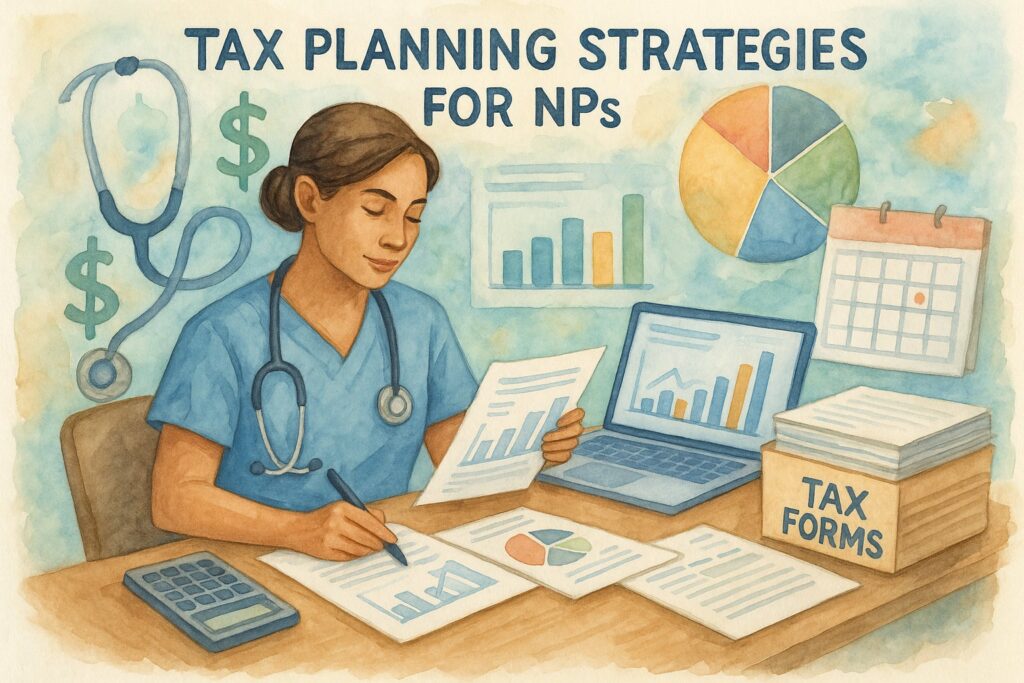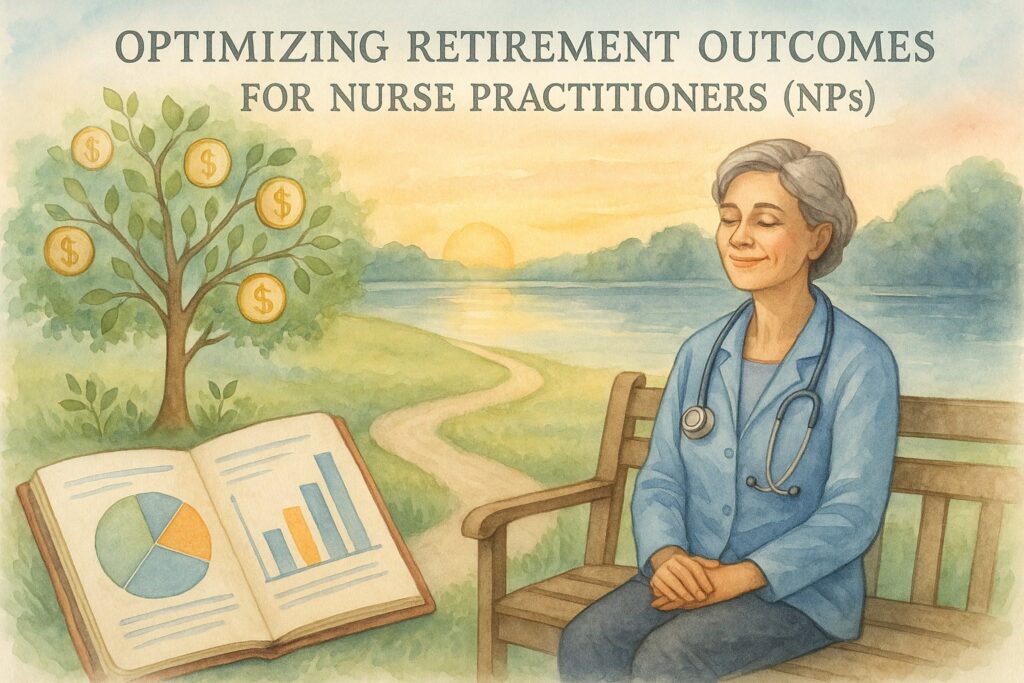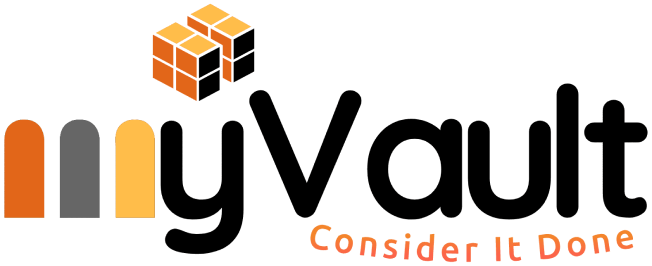
Owning a nurse practitioner business brings both independence and responsibility, especially when it comes to managing taxes. The right strategies can help you keep more of what you earn while staying compliant with tax laws. Effective tax planning allows you to reduce liabilities, maximize deductions, and strengthen the financial health of your practice.
You face unique expenses such as licensing fees, continuing education, and professional liability coverage that can qualify as deductions. Choosing the right business structure, contributing to retirement accounts, and using tools like a Health Savings Account can also create significant tax advantages over time.
By taking a proactive approach, you can simplify tax season, avoid costly mistakes, and keep your focus on growing your practice. Strategic planning now sets the foundation for long-term financial stability and success.
Key Takeaways
- Smart tax planning reduces liabilities and protects your income
- Retirement and savings strategies create long-term advantages
- Year-round organization ensures smooth compliance and fewer surprises
Essential Tax Planning Strategies

Your tax obligations as a nurse practitioner business owner depend on how you structure your business, track expenses, and plan for self-employment income. Careful planning helps you reduce taxable income, stay compliant, and avoid unexpected liabilities.
Choosing the Right Business Structure
The legal structure you choose affects your taxes, liability, and administrative requirements. Sole proprietorships are simple to set up but leave you personally liable for business debts.
Forming an LLC offers liability protection and flexibility in how you are taxed. You may elect to be taxed as an S-Corporation, which can reduce self-employment tax by paying yourself a reasonable salary and taking additional income as distributions.
Partnerships may be useful if you co-own a practice, but they require more complex reporting. Consider your income level, risk exposure, and long-term goals when selecting the structure. Consulting with a tax professional before deciding helps you avoid costly restructuring later.
Maximizing Deductions for Nurse Practitioners
You can lower taxable income by carefully tracking deductible expenses. Common deductions include:
- Office rent and utilities
- Medical equipment and supplies
- Continuing education and licensing fees
- Professional liability insurance
- Mileage or vehicle expenses for business travel
If you work from home, you may qualify for the home office deduction. This requires that the space is used regularly and exclusively for business.
Health insurance premiums you pay for yourself and your family may also be deductible. Keeping detailed records and using accounting software can help ensure you capture every eligible expense.
Quarterly Estimated Tax Payments
As a business owner, you are responsible for paying taxes throughout the year, not just at filing time. The IRS requires quarterly estimated payments if you expect to owe at least $1,000 in tax after withholding.
Payments are due in April, June, September, and January. Missing these deadlines can result in penalties and interest.
To calculate your payments, use last year’s tax liability as a guide or estimate based on your current income. Many practitioners set aside a percentage of each payment they receive to cover taxes. Automating transfers into a separate tax savings account can make this process easier.
Tax Planning for Self-Employment Income
Self-employment income is subject to both income tax and self-employment tax, which covers Social Security and Medicare contributions. This often surprises new business owners because the combined rate is higher than employee payroll withholding.
You can reduce the burden by contributing to retirement accounts such as a SEP IRA, Solo 401(k), or SIMPLE IRA. These accounts allow large contributions that lower taxable income.
An HSA (Health Savings Account) is another option if you have a high-deductible health plan. Contributions are tax-deductible, grow tax-free, and can be used for qualified medical expenses.
Planning ahead for these obligations ensures you avoid cash flow problems and maximize long-term savings.
Retirement Planning and Tax Advantages

You can reduce taxable income while building long-term savings through retirement plans designed for self-employed professionals. Certain accounts allow you to defer taxes or grow funds tax-free, while specific contribution rules and deadlines determine how much you can save each year.
Setting Up Retirement Accounts
As a nurse practitioner business owner, you have access to retirement accounts that go beyond standard employer-sponsored plans. Options like a SEP IRA, Solo 401(k), or traditional IRA provide flexibility depending on your income and structure.
A SEP IRA is simple to establish and works well if you want low administrative requirements. A Solo 401(k) allows higher contribution limits and additional features, such as Roth contributions, which can be valuable if you expect higher future tax rates.
You should also consider whether you want tax-deferred growth or tax-free withdrawals. Traditional accounts reduce taxable income now, while Roth options require after-tax contributions but allow tax-free withdrawals in retirement. Choosing the right account depends on your business income, filing status, and long-term financial goals.
Tax Benefits of SEP IRAs and Solo 401(k)s
Both SEP IRAs and Solo 401(k)s provide significant tax advantages. Contributions are deductible as a business expense, directly lowering your taxable income. This can reduce both federal income tax and self-employment tax obligations.
A SEP IRA allows you to contribute up to 25% of your net earnings from self-employment, making it attractive if you want flexibility in contribution amounts. It’s easy to set up and requires minimal paperwork.
A Solo 401(k) provides higher contribution potential because you can contribute both as the employer and the employee. This plan also allows catch-up contributions if you are age 50 or older. Unlike a SEP IRA, it may also offer a Roth option, giving you tax-free growth on part of your savings.
Contribution Limits and Deadlines
Contribution limits vary depending on the type of plan. For 2025, you can contribute up to $23,000 to a Solo 401(k) as an employee, plus 25% of business earnings as the employer. If you are age 50 or older, you may add an extra $7,500 in catch-up contributions.
A SEP IRA allows contributions up to 25% of your net self-employment income, capped at $69,000 in 2025. Unlike IRAs, these accounts have later funding deadlines, often until your business tax filing date, including extensions.
Meeting these deadlines is critical to securing the deduction for the given tax year. Careful planning ensures you maximize contributions without exceeding IRS limits, which could result in penalties or required corrections.
Advanced Tax Reduction Techniques

You can reduce taxable income by shifting earnings within your household, using tax-advantaged health accounts, and applying deductions designed for small business owners. These methods require accurate documentation and compliance with IRS rules but can lead to meaningful savings when implemented correctly.
Income Splitting and Family Employment
Hiring family members allows you to move income from a higher tax bracket to a lower one. For example, if you employ your spouse or teenage child in legitimate roles such as administrative support or bookkeeping, their wages become deductible business expenses.
This strategy reduces your taxable business income while providing income to family members who may fall into lower brackets. Payments must reflect fair market value for the work performed, and hours should be documented.
You can also benefit from payroll tax advantages. For children under 18 employed by a sole proprietorship or partnership owned by parents, you generally avoid Social Security and Medicare taxes on their wages. This makes family employment particularly effective for nurse practitioner practices structured as sole proprietorships.
Leveraging Health Savings Accounts
A Health Savings Account (HSA) provides a triple tax benefit: contributions are deductible, growth is tax-free, and withdrawals for qualified medical expenses are not taxed. If you pair your business health plan with a high-deductible policy, you can contribute to an HSA each year.
For 2025, the contribution limits are $4,300 for self-only coverage and $8,550 for family coverage, with an additional $1,000 allowed if you are age 55 or older. Contributions can come directly from your business, further reducing taxable income.
You can also use the account to pay for medical expenses that insurance does not cover, such as dental or vision care. Unlike Flexible Spending Accounts, unused funds roll over each year, allowing you to build a sizable reserve for future healthcare costs.
Utilizing Section 199A Deductions
Section 199A offers a 20% deduction on qualified business income (QBI) for eligible pass-through entities, including sole proprietorships, partnerships, and S corporations. As a nurse practitioner business owner, you may qualify if your taxable income falls below the IRS thresholds.
For 2025, the phase-out begins at $191,950 for single filers and $383,900 for joint filers. If your income exceeds these levels, the deduction may be limited or unavailable. Careful income management, such as deferring income or increasing retirement contributions, can help keep you within the qualifying range.
It’s important to distinguish between QBI and other types of income like capital gains or dividends, which do not qualify. Maintaining accurate bookkeeping and consulting with a tax advisor ensures you maximize this deduction without triggering compliance issues.
Year-End Tax Preparation and Compliance

Closing out the year requires you to review financial records, confirm compliance with reporting requirements, and prepare accurate filings. Careful organization, professional guidance, and attention to common errors help you reduce unnecessary costs and avoid penalties.
Organizing Financial Records
Keep your income and expense records updated throughout the year. Gather bank statements, credit card records, invoices, payroll reports, and receipts in one place before year-end. This makes it easier to identify deductible expenses such as continuing education, licensing fees, and business-related travel.
Use accounting software or a secure cloud-based system to categorize transactions. Consistent categorization ensures you don’t miss deductions and makes your tax return more accurate.
Consider creating a year-end checklist:
- Income records: 1099s, patient billing statements, insurance reimbursements
- Expense records: medical supplies, rent, utilities, mileage logs
- Retirement contributions: SEP IRA, Solo 401(k), or SIMPLE IRA statements
Maintaining organized records not only simplifies filing but also strengthens your position if the IRS requests documentation.
Working With a Tax Professional
A tax professional can guide you through complex rules that apply to nurse practitioners operating as sole proprietors, S-Corps, or LLCs. They help you determine the most tax-efficient structure and ensure compliance with estimated payments.
By reviewing your financials before the year ends, a CPA can recommend strategies such as accelerating expenses or deferring income to reduce taxable income. They can also confirm that retirement contributions are maximized within annual limits.
When selecting a professional, look for someone with experience in healthcare businesses. Ask about their approach to quarterly tax planning, audit support, and state-level compliance. Establishing a year-round relationship ensures you receive timely advice rather than only at filing time.
Avoiding Common Tax Filing Mistakes
Many business owners make errors that increase their tax liability or trigger penalties. Failing to track estimated payments, misclassifying expenses, or overlooking home office deductions are frequent issues.
Double-check that your business and personal expenses remain separate. Mixing accounts complicates recordkeeping and can raise questions during an audit.
Another common mistake is missing filing deadlines. Use a calendar with reminders for quarterly estimated taxes, payroll filings, and annual returns. Filing electronically reduces errors and provides faster confirmation of acceptance.
Finally, review deductions carefully. Claim only legitimate business expenses supported by documentation. Overstating deductions can result in penalties, while understating them means you pay more than necessary.
Frequently Asked Questions
You can reduce your tax burden by using deductions, choosing the right business structure, and setting up retirement accounts. Careful recordkeeping and understanding the difference between contractors and employees also play a key role in your tax planning.
What are the best tax deduction strategies for nurse practitioner business owners?
You can deduct ordinary and necessary business expenses such as office rent, medical supplies, continuing education, and professional insurance. Technology costs, marketing expenses, and mileage related to patient care also qualify.
If you work from home, you may claim a home office deduction if the space is used exclusively for your practice.
How can a nurse practitioner business owner structure their business for optimal tax benefits?
Your choice of structure—sole proprietorship, partnership, LLC, or S corporation—affects both taxes and liability. An LLC can provide flexibility while separating personal and business assets.
Electing S corporation status may reduce self-employment taxes by allowing you to take part of your income as distributions rather than wages.
What retirement plan options offer the most tax advantages for nurse practitioner entrepreneurs?
You can consider a SEP IRA, which allows higher contribution limits and is simple to administer. A Solo 401(k) offers both employee and employer contributions, creating more room for tax-deferred savings.
A SIMPLE IRA may be a good choice if you have employees and want a straightforward plan.
Are there specific tax credits that nurse practitioner business owners should be aware of?
You may qualify for the Qualified Business Income (QBI) deduction, which allows you to deduct up to 20% of eligible business income.
If you provide health insurance to employees, you could be eligible for the Small Business Health Care Tax Credit. Energy-efficient equipment purchases may also qualify for certain credits.
How can nurse practitioner business owners effectively track expenses for tax purposes?
Separate your business and personal accounts to avoid confusion. Use accounting software or a bookkeeping system to record income and expenses consistently.
Keep receipts, invoices, and mileage logs organized throughout the year to support your deductions if audited.
What are the implications of hiring independent contractors versus employees for tax purposes?
Hiring employees requires you to withhold taxes, pay employer payroll taxes, and provide necessary benefits. This increases administrative responsibility but gives you more control over their work.
Independent contractors handle their own taxes, and you issue them a Form 1099. This reduces your tax obligations but limits the control you can legally exert over how they perform their work.
Need Help? SUBMIT INQUIRY

https://shorturl.fm/PK19Q
https://shorturl.fm/Pcjt8
https://shorturl.fm/9KRVl
https://shorturl.fm/gbGE0
https://shorturl.fm/3hChf
https://shorturl.fm/1LrsD